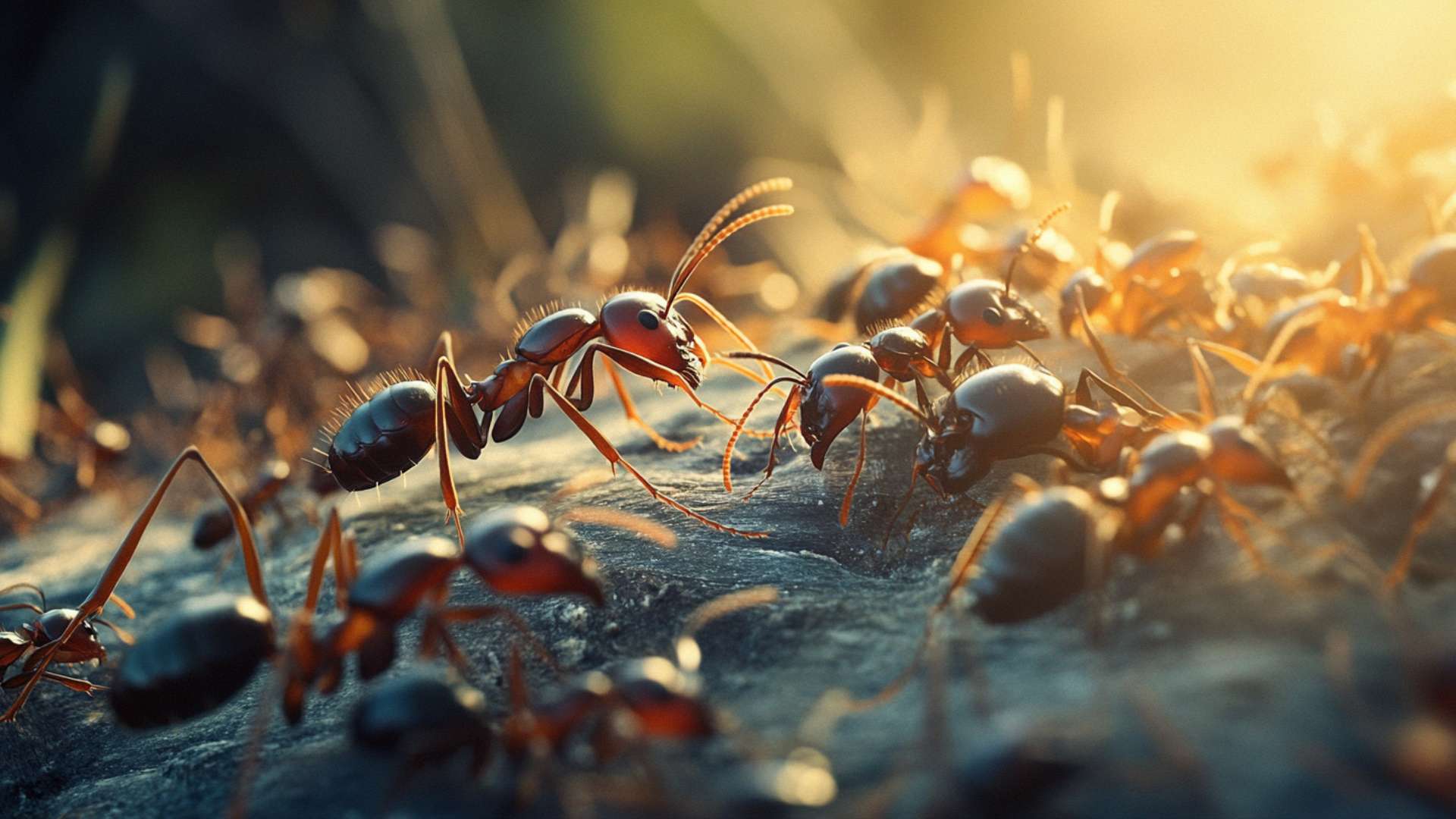Ants, those tiny but mighty creatures, have captivated the curiosity of humans for centuries. With their complex societies and remarkable teamwork, it’s no wonder they continue to intrigue us.
But have you ever wondered what fuels these industrious insects? In this article, we dive into the fascinating world of ants and unveil their diverse dietary habits.
Fascinating world of ants and their dietary habits
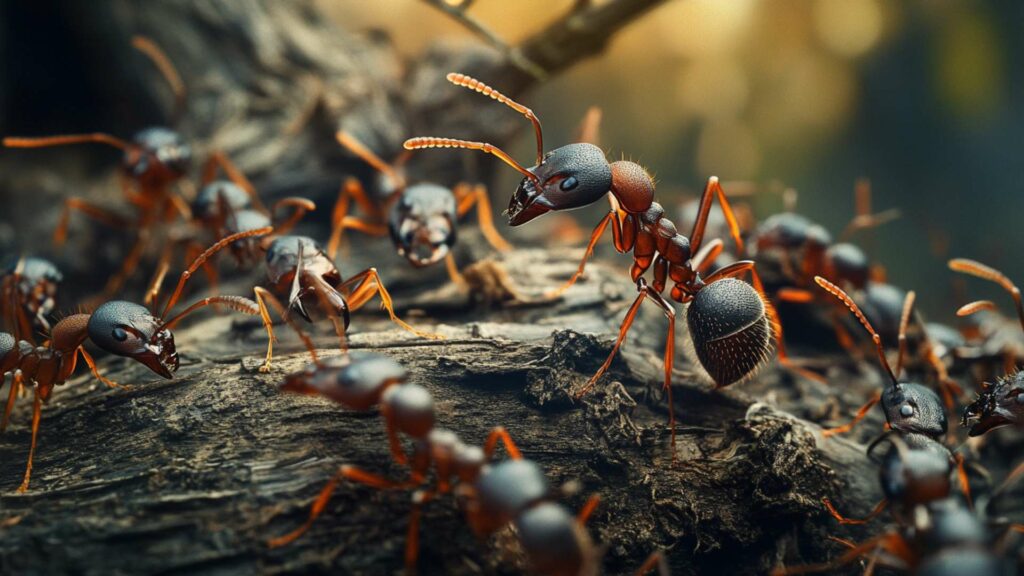
Ants are omnivorous creatures that feast on a wide array of foods. Their diets vary depending on species, colony needs, and individual roles within the ant community. From plant matter to other insects, these resourceful arthropods make use of whatever they can and eat just about anything they can find.
One of the primary sources of nutrition for most species of ants is plant-based foods. Many ant species have a sweet tooth and indulge in nectar and honeydew secretions.
They visit flowers to collect nectar using their unique body structure that allows them to carry this sweet liquid back to the nest. Additionally, some ants engage in a mutualistic relationship with plants by tending to aphids that produce honeydew—a sugary secretion that serves as an essential food source for both ants and aphids.
On the other hand, protein-rich foods also play a crucial role in ant diets. Ants showcase impressive hunting skills as they scavenge for small insects like flies, mosquitoes, or even caterpillars.
They rely on their chemical sensing system (pheromones) to communicate with fellow workers when they find a potential meal. Not only do ants hunt live prey but also show no hesitation in feasting on dead animals or decaying organic matter found in their surroundings.
Whether it’s collecting nectar from flowers or hunting down unsuspecting insects, ants exhibit incredible adaptability when it comes to finding food sources. Stay tuned as we explore further into specialized diets among different ant species and uncover more intriguing aspects of these remarkable creatures and other species’ eating habits.
The General Diet of Ants
Omnivorous Nature of Ants
Ants, those tiny but industrious creatures, have earned a well-deserved reputation for their adaptable and versatile eating habits. Much like us humans, ants are omnivores, meaning they consume both plant and animal matter. This dietary flexibility sets them apart from many other insects that have specific feeding preferences.
While some ants lean more towards a herbivorous diet, others have carnivorous tendencies. These resourceful insects have evolved to exploit diverse food sources based on the availability in their environment.
Primary Sources of Nutrition for Ants
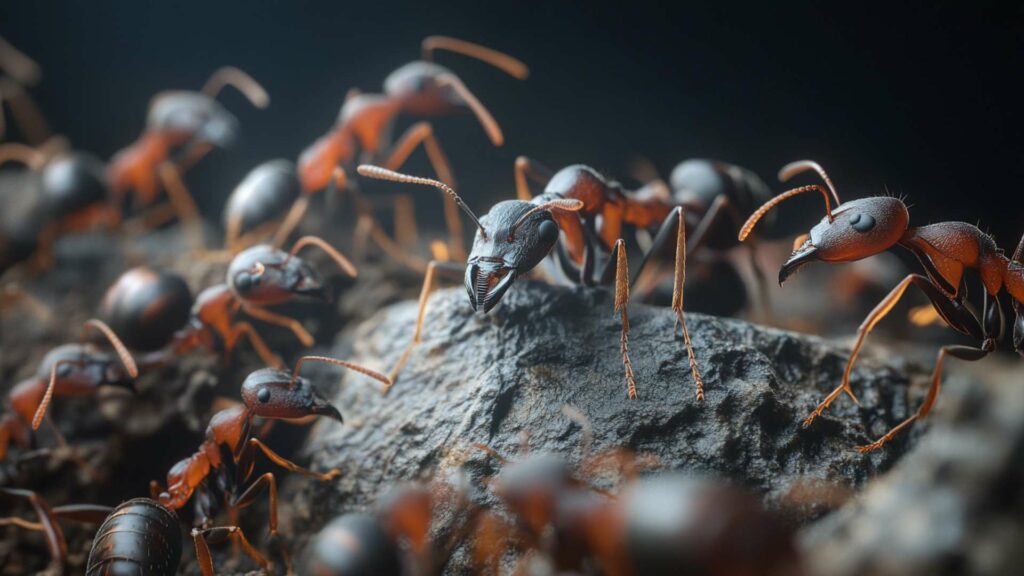
When it comes to the primary sources of nutrition for what ants eat, it greatly depends on the species and their ecological niche. For most common species most ants like pavement ants or thief ants, a substantial portion of their diet consists of carbohydrates derived from plant-based materials.
They diligently collect nectar from flowers and eat honeydew secreted by aphids or scale insects as a sweet food source. Additionally, they engage in seed-feeding activities and may munch on fruits or chew leaves for sustenance.
On the other hand, other ant species prioritize proteins as a vital component of their diet. They actively hunt other insects such as spiders other ants or bugs to supplement their nutritional needs.
Some ants are even known to scavenge on dead animals or feed on decaying organic matter that they come across in their journeys. This adaptability enables them to make the most out of any available food source within their territory.
Ants are remarkable creatures with an omnivorous nature that allows them to thrive in various ecosystems across the globe. Their primary sources of nutrition include plant-based materials like nectar and honeydew while also encompassing proteins obtained from human food or through hunting or scavenging activities.
The ability to adapt their diets according to ecological conditions makes these tiny workers successful survivors in the intricate web of life. So, the next time you spot ants bustling around your picnic area or exploring your kitchen, marvel at their remarkable dietary habits and appreciate their role in maintaining the delicate balance of nature.
Plant-Based Diet
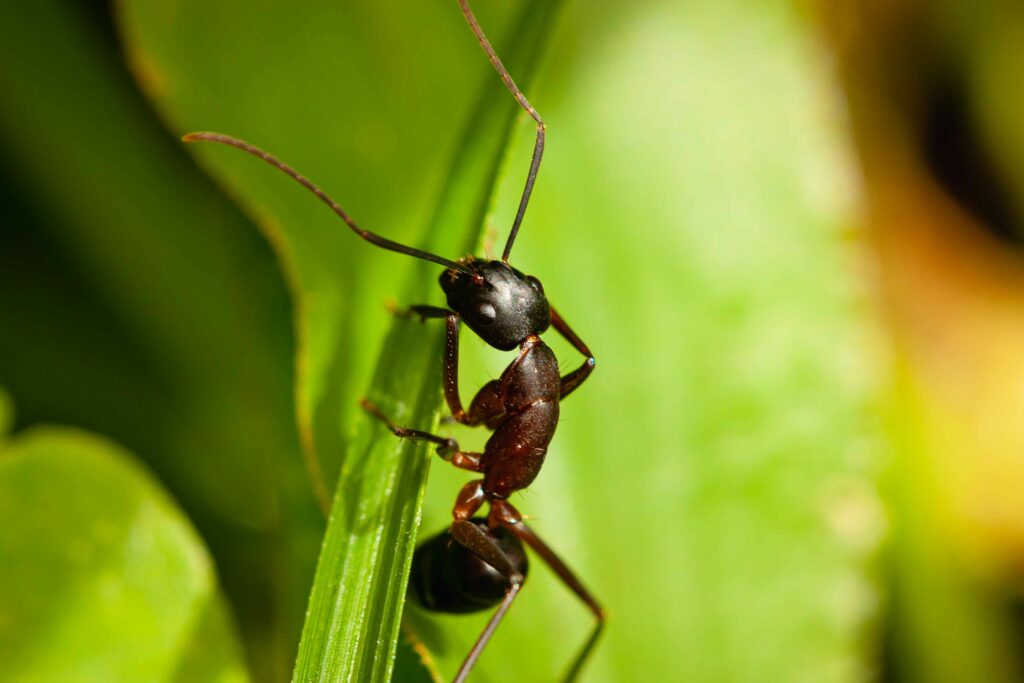
Consumption of Nectar and Honeydew
When it comes to their plant-based diet, ants have a particular fondness for sweet foods. They can often be seen feasting on other ants drink the sugary nectar produced by flowers.
By delicately sipping this liquid food, ants not only satisfy their sweet tooth but also play a vital role in pollination. As they move from one flower to another, these diligent little creatures inadvertently transfer pollen, aiding in the reproductive cycle of plants.
Another source of sweetness for ants is honeydew, a sticky secretion produced by aphids and other sap-sucking insects. Ants have developed a unique relationship with these tiny creatures.
They “farm” aphids by protecting them from predators and transporting them to suitable plants to feed on their sap. In return, the aphids excrete honeydew which the ants eagerly consume, forming a mutually beneficial arrangement.
Harvesting Seeds, Fruits, and Leaves
Ants are not solely reliant on the sweet bounty provided by flowers and aphids; they also demonstrate an appetite for various plant parts. Some ant species diligently collect seeds as part of their diet.
They harvest these seeds from plants and carry them back to their nests where they serve as stored food reserves or are even used for cultivation purposes in some cases. In addition to seeds, fruits are another category that ants find appealing.
Whether it’s juicy berries or fleshy fruits that have fallen from trees, ants waste no time devouring these nutrient-rich treats. Their efficient teamwork allows them to haul larger pieces of fruit back to their nests where they can be shared among colony members.
Furthermore, certain ant species exhibit leaf-eating behavior. Leaf cutter ants, found primarily in South America, are renowned for their ability to strip foliage off trees with astonishing precision.
However, they don’t actually consume the leaves themselves. Instead, they use them to cultivate a fungus within their nests, which becomes their primary food source.
Mutualistic Relationships with Plants
It is fascinating to observe how ants and plants have forged mutually beneficial relationships over time. Some plants have evolved special structures called extrafloral nectaries to attract ant colonies.
These nectaries produce sugary substances that serve as a tempting meal for hungry ants. In return for this sweet reward, the ants provide defense against herbivores and other bugs, deterring insects from feasting on the plant’s leaves or flowers.
Another intriguing example of such a relationship can be seen with myrmecophytes, plants specifically adapted to hosting ant colonies. These remarkable plants offer shelter and food sources to other colonies in the form of specialized structures known as Beltian bodies.
Ants feed on these nutritious bodies while also providing protection from unwanted intruders by aggressively driving away potential threats that might harm their plant hosts. Ants exhibit diverse dietary preferences within their plant-based diet.
Their consumption ranges from sipping nectar and honeydew for their sweet fix to harvesting seeds and fruits as well as engaging in mutually beneficial partnerships with various plants. Through these relationships, ants not only satisfy their own hunger but also contribute significantly to the survival and propagation of plant species in ecosystems worldwide.
Protein-Rich Diet

Hunting small insects and arthropods
Ants are not only expert foragers but also skilled hunters when it comes to procuring protein-rich meals. Many ant species have evolved strong mandibles and sharp claws, allowing them to capture and subdue small insects and arthropods.
These formidable hunters employ a variety of strategies, such as ambush tactics or coordinated group efforts, to overpower their prey. They display remarkable precision and agility in targeting their victims, often working together as a united front.
For instance, the infamous army ants employ cooperative hunting strategies that are nothing short of astonishing. These nomadic predators travel in large swarms, overwhelming their prey with sheer numbers and coordination.
They can efficiently swarm over spiders, beetles, termites, and other unsuspecting invertebrates that cross their path. With an insatiable appetite for protein-rich meals, army ants leave no stone unturned in their relentless search for sustenance.
Scavenging on dead animals and other organic matter
In addition to hunting live prey and human food, ants are also opportunistic scavengers that make the most out of available resources within their surroundings. When an animal succumbs to natural causes or becomes roadkill on the pavement, ants quickly detect the scent of decomposition through chemical signals released into the air. They waste no time in swarming around these carcasses like tiny undertakers.
Ants not only scavenge on dead animals but also feast upon other organic matter such dead insects well as decaying plant material or fallen fruits from trees. This scavenging behavior of most ants ensures that no potential food source goes to waste within their territory.
In this way, ants play a crucial role in ecosystem maintenance by breaking down organic materials back into nutrients that can be recycled by other organisms. Whether it’s through hunting down smaller creatures or efficiently scavenging on decaying matter, ants exhibit a wide array of protein-rich dietary habits.
Their resourcefulness and adaptability contribute to their survival and the overall balance of their ecosystems. From tiny black ants to large Argentine ants, their insatiable appetite for protein fuels the energy needed to sustain their colonies and ensure their continued success.
Leaf-cutter ants: Fungus farmers with a taste for foliage
Cultivating fungus as their primary food source
Leaf-cutter ants, those tireless and industrious workers of the insect world, have developed a remarkable way to feed themselves by cultivating fungus. This process begins with the worker ants venturing out in search of fresh leaves from various plant species.
These ants eat leaves that serve as the substrate for their fungal gardens. Upon finding suitable foliage, the ants use their strong mandibles to meticulously cut out small leaf fragments, which they then carry back to their colonies.
Leaf-cutting behavior nourishing the fungus gardens
Once back at the colony, the leaf fragments are not immediately consumed but instead used to grow fungus. The worker ants chew these leaf pieces into a pulp-like consistency, creating an ideal medium for fungal growth. They carefully cultivate and tend to this fungal garden by regulating temperature and humidity levels.
The cultivated fungus then becomes the primary food source for the entire ant colony. To ensure continued growth and sustenance of their precious fungus, leaf-cutter ants maintain impeccable hygiene within their colonies.
They actively remove any competing molds or unwanted bacteria that might threaten their thriving fungal gardens. This dedicated caretaking ensures a constant supply of nutritious food for the colony.
Supplementary food sources for leaf-cutter ants
While cultivating fungus is essential for their survival, it does not completely satisfy all nutritional needs of leaf-cutter ants. As such, these resourceful insects have developed additional supplementary food sources. One such source is honeydew—a sweet liquid produced by aphids and other sap-sucking insects— which is eagerly collected by worker ants during their foraging expeditions.
Leaf-cutters maintain mutualistic relationships with aphids where they protect them from predators while benefiting from this sugary liquid treat. Furthermore, when the fungus growth is insufficient or during periods of scarcity, leaf-cutter ants show their adaptability by diversifying their diet.
They scavenge for other food sources such as insect eggs, seeds, and even flowers. This dynamic approach to nourishment ensures their survival in challenging times.
Army ants: Carnivorous nomads on the hunt
Cooperative hunting strategies
In contrast to leaf-cutter ants’ farming lifestyle, army ants have adopted a more nomadic and carnivorous existence. With a ferocious hunger for protein-rich meals, these formidable insects engage in cooperative hunting strategies that would make any military general proud.
Army ants venture out from their colonies in massive swarms called “raids.” These raids can consist of thousands or even millions of worker fire ants together, forming an impressive force ready to conquer prey. The sheer number and organized movements of fire ants in these raiding parties overwhelm their victims, ensuring the success of the hunt.
Preying on various invertebrates, including spiders and insects
Once an army ant raid is underway, no creature within its path is safe from becoming part of the menu. These voracious hunters prey on a wide range of invertebrates such as spiders, insects (including other ant species), and larvae. Their sharp mandibles make quick work of capturing and subduing their quarry.
Remarkably adaptable predators, army ants are equipped with specialized appendages called “tarsi” that enable them to scale vertical surfaces with ease. This unique ability allows them to access potential hiding places for prey that might otherwise go untouched by less agile predators.
In addition to live prey, army ants also scavenge on dead insects, animals, or organic matter encountered during their raids. Their opportunistic nature enables them to capitalize on any available food sources they come across during their relentless search for sustenance.
Remembering that nature provides diverse answers to the question “what, what do ants eat now” lends us a deeper appreciation for these tiny creatures and their incredible adaptability. From the leaf-cutter ants’ sophisticated farming practices to the army ants’ cooperative hunting strategies, ants demonstrate remarkable resourcefulness in finding their next meal.
Unusual Dietary Habits in Ants
Aphid farming: Tending to aphids for their sugary secretions
Ants, those industrious little creatures, have developed some remarkable habits when it comes to securing their food sources. One fascinating behavior observed in ants is their tendency to engage in “aphid farming.” These tiny insects, known as aphids, are sought after by ants primarily because of the sweet secretions they produce.
It’s like having a sugary buffet right at their disposal! Aphids feed on plant sap and excrete a substance called honeydew which is rich in sugars.
The astute ants have recognized this golden opportunity and formed a mutually beneficial relationship with these pesky pests. They carefully tend to the aphids, protecting them from predators and even moving them to more favorable locations for feeding.
In return, they get access to the delectable honeydew that flows from the bodies of these miniature sugar factories. It’s an ingenious arrangement where both parties reap the rewards.
Myrmecophytes: Symbiotic relationship between ants and plants
In nature’s most captivating symphonies of coexistence, some plants have forged unique alliances with ants known as myrmecophytes. These plants possess specialized structures that attract ant colonies, offering a constant source of food and shelter in return for protection against herbivores or other threats. One way myrmecophytes lure ants is through extrafloral nectaries.
These are nectar-producing glands found on the leaves, stems, or other parts of the plant that provide sustenance for hungry ant workers. Imagine little ant workers finding their own version of an all-you-can-eat buffet right on the very plant they call home!
Another adaptation employed by myrmecophytes that entices ants to eat leaves is the presence of Beltian bodies. These small, protein-rich structures are commonly found on the tips of leaflets or leaf stalks and serve as specialized food bodies for ants.
It’s like having a gourmet treat at their disposal, ensuring a steady supply of nutrients for both ant colonies and the plants that house them. In this intricate dance between ants and myrmecophytes, both parties find solace in an unbreakable bond: ants receive nourishment from these plant partners while providing protection against herbivores, creating a harmonious relationship that has stood the test of time.
As we delve into the world of ants, we discover their remarkable ability to adapt their dietary habits to suit their surroundings. Whether it’s farming aphids for sweet sustenance or fostering symbiotic relationships with myrmecophytes, these industrious creatures have mastered the art of survival through innovative strategies.
Understanding the diverse culinary preferences of different ant species sheds light on their vital ecological roles. From being nature’s pest control experts, preying on other insects and dead animals, to forming mutualistic alliances with plants for sustenance—ants hold food and truly showcase nature’s intricate web of interdependence.
So next time you spot those diligent little black ants marching along or carpenter ants excavating their nests, take a moment to appreciate the hidden world they inhabit and the incredible variety in what they eat. After all, isn’t it fascinating how these tiny creatures have mastered survival by exploring such a diverse range of food sources?
Nutritional Adaptations in Ants
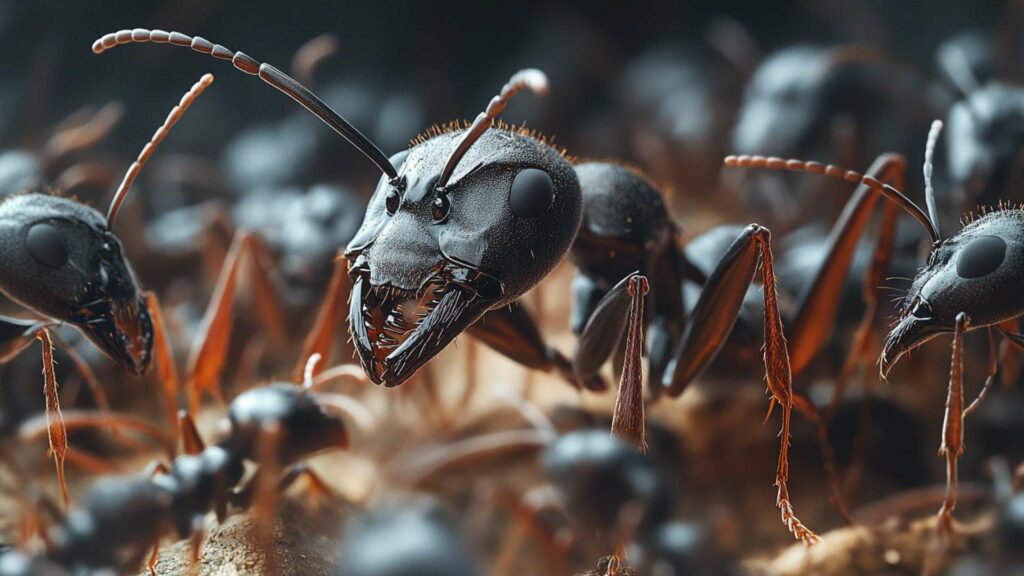
Caste system within ant colonies allowing specialization
Within the intricate social structure of ant colonies, a caste system emerges as a remarkable adaptation to meet various nutritional needs. Ant colonies consist of different castes, including queens, males, and other workers below.
The workers, who are responsible for the majority of tasks within the colony, display an impressive level of specialization when it comes to their dietary preferences. Some workers are tasked with foraging for food, while others focus on caring for the brood or defending the colony.
The workers that gather food exhibit specialized adaptations depending on their preferred food sources. For example, sugar ants have evolved specialized mouthparts to efficiently feed on sugary foods such as nectar and honeydew secretions.
Their mouthparts are designed to facilitate sipping or lapping up these sweet substances. On the other hand, ants that eat meats or other animal-based food sources may have strong mandibles that enable them to dismantle prey or scavenge from carrion.
Dietary preferences based on colony needs
The dietary preferences of ants can also vary based on the specific needs of their colony. Ant colonies prioritize nourishing their brood—ant larvae and eggs—which requires an ample supply of proteins and nutrients.
Therefore, worker ants often focus on collecting protein-rich foods such as insect eggs or dead animals to feed the growing larvae. Furthermore, some species of sugar ants adapt their feeding habits according to resource availability in different species in their environment.
If there is standing water nearby, certain ant species may rely more heavily on aquatic insects or other organisms found in wet habitats as part of their diet. This flexibility in dietary preferences helps ensure a steady supply of nutrients even when specific food sources are scarce.
Nutritional adaptations in ants showcase both individual specialization within the caste system and an ability to adapt based on colony needs. These adaptations allow ants to efficiently gather and utilize food sources to sustain their colonies, ensuring the survival and growth of their intricate societies.
Conclusion
A Diverse Culinary Adventure: Ants’ Wide Range of Dietary Habits
Throughout the vast world of ants, one quickly realizes the astonishing diversity of their dietary habits. From omnivorous generalists to specialized leaf-cutters and carnivorous nomads, these industrious insects exhibit an array of feeding strategies that have allowed them to thrive in various ecosystems. It is truly remarkable how ants have adapted to consume an assortment of foods, ranging from plant-based diets consisting of nectar, honeydew secretions, fruit, and leaves to protein-rich meals comprising small insects and scavenged organic matter.
One cannot help but marvel at the ingenuity displayed by certain ant species when it comes to acquiring sustenance. For instance, leaf-cutter ants exemplify a highly evolved strategy as they cut and transport fresh foliage back to nourish their fungal gardens.
These fascinating creatures engage in a symbiotic relationship with fungi they cultivate, providing them with suitable conditions while feeding on the fungus for sustenance. Similarly, army ants exhibit cooperative hunting behaviors, swarming their prey and devouring various invertebrates along their nomadic trails.
There are also peculiar dietary habits observed among certain ant species that add a touch of intrigue to their already captivating nature. For example, some ants engage in aphid farming where they tend to aphids for their sugary secretions.
This mutualistic relationship between ants and aphids provides both parties with benefits: the aphids receive protection from natural predators while the ants enjoy a sweet treat. Additionally, myrmecophytes are plants that have evolved special adaptations such as extrafloral nectaries or beltian bodies specifically tailored to attract ant colonies for food provisions.
In exploring the astonishing variety found within ant dietary preferences, we gain insight into nature’s complex web of interactions. The ability of these remarkable insects to adapt their feeding behaviors based on the needs of their colonies is truly remarkable.
Through their strong mandibles and tireless foraging efforts, ants ensure the survival and success of their entire colony, maintaining a delicate balance within ecosystems. Embracing the diversity of other ants” dietary habits serves as a reminder that even in the tiniest corners of our world, intricacies abound.
As we marvel at these remarkable creatures’ adaptability and resourcefulness, we are encouraged to appreciate the intricacies and wonders that exist within the natural world. Let us remain curious observers, always ready to discover new insights into the fascinating lives of ants and their culinary adventures.
Keep Ants at Bay with D-Termination: Las Vegas’ Top Pest Control Choice!

Dealing with ant problems? D-Termination is here to help. Our skilled team excels at deterring ants, revitalizing cleanliness and integrity in your environment. Bid farewell to ants—opt for D-Termination for effective pest control today!
Reach out to us at 702-919-6310 or visit dtermination.com to schedule your ant control service and regain your space from these unwelcome pests.
Frequently Asked Questions:
Ants in your house typically eat a variety of food scraps, sugary substances, and protein sources.
Some ants may have preferences for certain foods, but it can vary by species.
Ants tend to dislike strong-smelling scents like vinegar, peppermint, and citrus.
Ants cannot consume foods that are toxic to them, like certain chemicals or substances.

